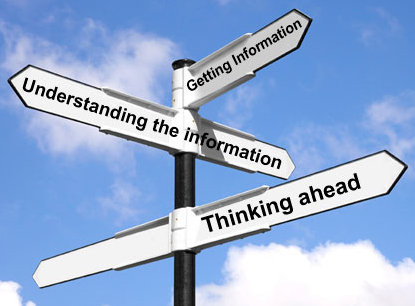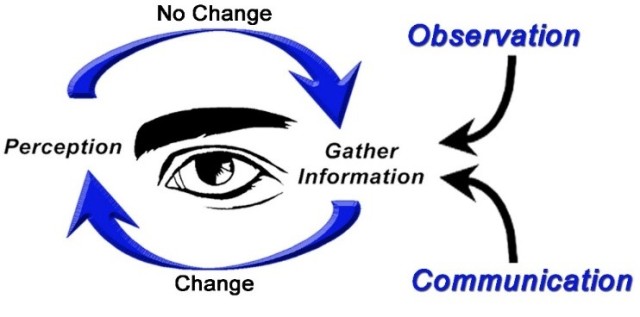There are many articles published in books and on online outlining how to read a map, contours, grids, take bearings etc. What many of these seem to miss, is that on top of knowing the basics, you need to learn something far more important. Something that is going to help you, even without a map in front of you.

Situational Awareness.
Situational Awareness is the perception of environmental elements and events with respect to time or space, the comprehension of their meaning, and the projection of their future status.
In terms of outdoor navigation, it is your perception of environmental elements in relation to you, and your occupation of the surrounding space.
The essence of Situational Awareness is simple… perception vs. reality.
Situational Awareness can also be looked at as a constantly evolving picture of the state of the environment. Situational Awareness is not an event, but rather a process. It is an important skill to develop when out walking. Not just in the mountains, but anywhere that danger can be encountered.
Where this is important, is that despite having a map and the ability to use it, you still need to have an acute sense of what you are passing, where you are in the greater picture, and which way you are going. It’s more about your ability to feel your way through the environment and terrain.
To fully understand Situational Awareness, we need to understand its three stages.
- The perception of the relevant information.
- The comprehension and interpretation of that information
- The projection of their states into the future.

So how can this be used when walking and what does it mean?
The perception stage requires that you observe. Not just with your eyes but with all sensory inputs, whether they be touch smell or hearing. This can be one of the greatest challenges to an individual as you have to be constantly alert to what is happening around you at all times.
The comprehension and interpretation stage is where one attempts to comprehend and interpret the data collected in the first stage. While the collection of data and the perception of the relevant information are important, the comprehension and interpretation of that data cannot be overlooked.
The projection into the future stage is where you put it all together. Once the clues are interpreted, the next step is to predict how that information will affect your future environment and plans.
A good example of how these three stages can work is – Observing clouds, having a comprehension of what they mean, then projecting the weather before it happens.
Planning for rain rather than reacting to rain.
The ‘What if’ game.
Whenever I am out walking, whether it is in the hills on a flat moor and heathland I am constantly playing the ‘What If’ game. The idea is to keep my mind aware of what is always going on around me. I am visualising what if something was to happen to me of someone in my party, where is the nearest help, what is the quickest and safest way off the hill.
If I am walking across a featureless landscape in zero visibility how do I know if I am on course? How will I know that I am lost? By constantly pacing and measuring time and distance along with taking constant bearing I should have a good idea of where I am at any given time. However, by looking out for features that I see on the map I can react quicker when they do not appear.
By noting and speaking out aloud distinctive landmarks every 10 minutes, as I walk along a route. It will be easier to retrace my steps in the event of missing a waypoint. It is all about constantly observing, remembering interpreting and reacting to changes in the landscape and failings in my navigation.

Risks To Situational Awareness
No matter how hard we try we will always be distracted, take on too much in one go or be influenced by others rather than see what is there. We need to be aware of what can reduce and impair Situational Awareness and how we can prevent it.
Seven key factors that reduce situational awareness:
- Insufficient or poorly communicated information.
- Fatigue and stress.
- Task underload.
- Task overload.
- Group mindset.
- “Press on Regardless” philosophy.
- Degrading environmental conditions.
Ten methods to prevent the loss of situational awareness. These techniques should be considered frequently, and throughout the expedition:
- Actively question and evaluate your progress.
- Analyse your situation.
- Update and revise your image of the walk.
- Use assertive behaviours when necessary.
- Make suggestions.
- Provide relevant information without being asked.
- Ask questions as necessary.
- Confront ambiguities.
- State opinion on decisions/procedures.
- Refuse unreasonable requests.
Useful Tips in Situational Awareness
Finally, here are a list of additional tips, which come from a variety of sources. This list is not exhaustive and always remember that the world of Situational Awareness’ is constantly evolving and changing just like the environment around us:
- If something doesn’t look or feel right, then it probably isn’t right.
- Watch out when you are busy or bored.
- Old habits are hard to break.
- Expectations can reduce awareness.
- Things that take longer are less likely to get done right.
- It’s hard to detect something that isn’t there.
- Distraction comes in many forms.
- Don’t rely on reliable systems.
- Prevention is the best way to avoid emergencies, and Situational Awareness is one of the best forms of prevention there is.
Remember, map reading is not the be all and end all of navigation. Nor is the ability to use the latest electronic GPS navigation app or device. Navigation is more about how you interact with the environment around you. It is about your understanding of meteorology, topography and geology. But more than anything else, it is about being aware of what is going on around you.


Pingback: Situational Awareness — Hill-Walking For The Over 60’s | Ups and Downs of Family History V2.0